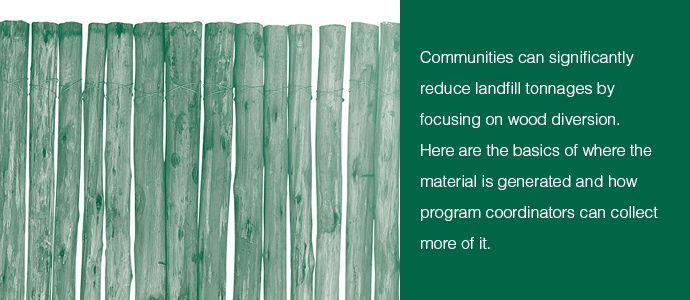
This article appeared in the January 2023 issue of Resource Recycling. Subscribe today for access to all print content.
Data from the U.S. Environmental Protection Agency shows that in 2010, the country produced roughly 11.1 million tons of wood that went to landfills, compared with 2.3 million tons that was recycled.
That dumped wood equated to more than $1 billion in potential revenue that could have been earned from selling for manufacturing or construction purposes.
Fast-forward to 2018 (the most recent year for which EPA data is available), and the waste wood that went to landfills grew to 12.2 million tons, making it almost 8.3% of all municipal solid waste heading to landfill.
Clearly, there are opportunities to improve collection and reuse for this material, and local recycling programs can be an important part of the solution. This article will offer local officials and others more details on this often-overlooked segment of the waste stream and provide some perspective on how to keep more tonnages in use, instead of in disposal.
Sources of generation
The primary source of wood waste in the U.S. is material cast off during residential construction projects. This category includes lumber, both new and used, generated during new builds or remodeling.
These materials may be too damaged to be reused in another home or building, but they are often safe for casual uses like landscaping projects or furniture-making if they can be effectively recovered.
Demolition waste is another source of waste wood – this material comes from old commercial buildings that have been demolished due to damage or obsolescence.
The wood from these buildings may be more damaged than that found on residential construction sites, but it’s still perfectly safe for use in other applications with basic carpentry skills and tools.
Firewood scraps are another type of scrap wood prime for reuse by someone with basic carpentry skills and tools. This material comes from trees cut down for firewood, but it has been deemed unsuitable for that purpose.
Scrap wood is also available from local sawmills that process trees into lumber products. The sizing and quality of scrap wood varies depending on production processes. Usually, this material is available at low cost and is ready for use immediately.
The local role
Local officials have a unique opportunity to improve the recycling of wood. They can do this by working with government officials in their state to ensure that wood is included in recycling programs.
Additionally, some local governments have launched robust wood recycling programs. Cities can recover wood with other yard waste, and many large cities have curbside collection programs for yard trimmings and other organic debris that could incorporate wood materials.
In other cases, municipalities accept wood for free at recycling drop-off centers.
These local recycling centers, which tend to collect materials in multiple streams (and thus keep quality high), allow small businesses and craftspeople to use recycled materials in their products without investing in large amounts of raw material.
To increase the recycling of unused wood, local recycling program coordinators must educate the public and make it easier for people to recycle this material.
Many people do not realize that it is possible to recycle unused wood. They may also have no idea where they can take their unwanted wood to be recycled.
Local recycling coordinators can take steps to let people know which types of wood can be recycled, including softwood, hardwood, blockboard, plywood, chipboard, hardboard and others.
The public also needs more information about how valuable wood can be when appropriately recycled and used again as building materials, furniture and other products.
Community momentum
Coordinators can work within their community to increase access to local recycling options. They can talk with local government leaders or other organizations about adding more drop-off locations for wood waste.
Sponsoring a wood waste collection event can be a great way to help people understand how important it is to recycle their unused wood.
A collection event can also help educate residents about how their local recycling center operates and what types of materials they accept for recycling.
Another step toward developing community momentum is talking with building contractors or businesses who might be willing to offer wood recycling bins near their construction sites or other places where they generate wood waste.
Additionally, coordinators can tell their state representatives that they want more waste diversion programs in their community or school district. They will then be able to pass on the message to other legislators who may be able to take action on this issue.
Ben Eagle is content manager at Carved, an Indiana company that uses recovered wood to design and manufacture handmade wooden cases for mobile phones. He can be contacted at ben@carvedteam.com
This article appeared in the January 2023 issue of Resource Recycling. Subscribe today for access to all print content.